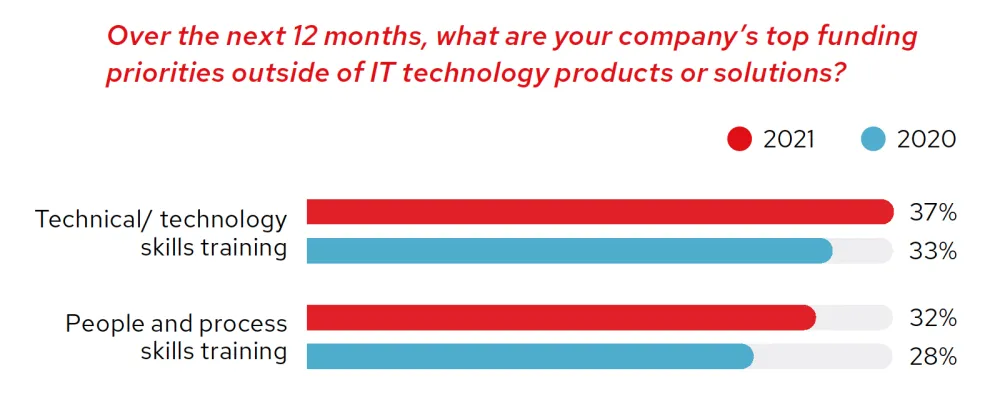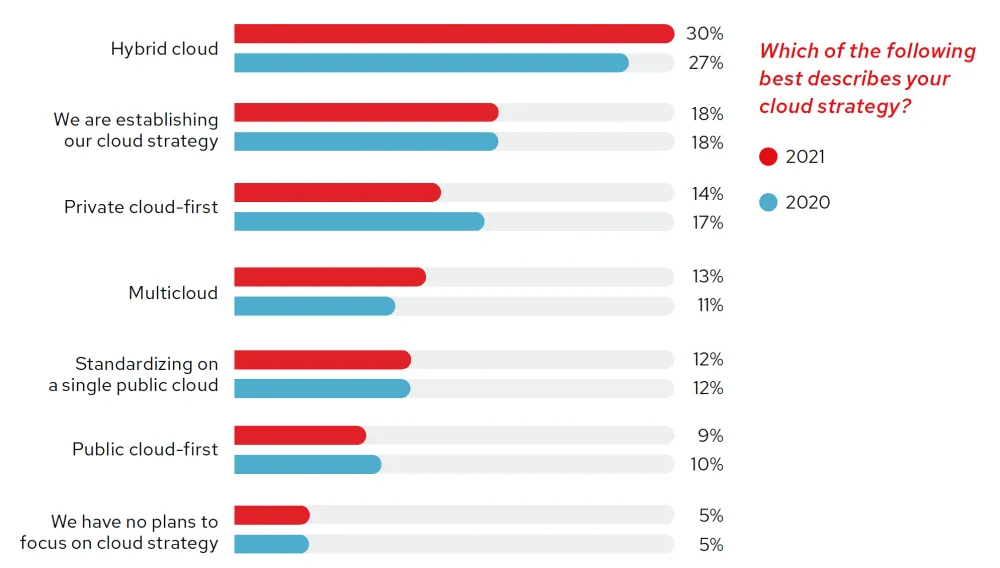In this year’s Red Hat 2022 Global Tech Outlook report, skill-set or talent gaps emerged as the top barrier organizations believe will prevent them from achieving their digital transformation goals. This was also reflected in organizations’ non-IT funding priorities for the next 12 months.
Red Hat develops a Global Tech Outlook report every year, and from June through August 2021, we surveyed 1,341 information technology (IT) leaders and decision makers to learn about their digital transformation journeys, their IT and non-IT funding priorities for the coming year, and the types of infrastructure they’re using to run their applications.
Red Hat 2022 Global Tech Outlook findings
The survey contained a number of questions that were directly or peripherally related to skills and training. One of these specifically addressed potential barriers to success in digital transformation efforts, for which “Skill-set or talent gaps” was one possible response.
In our previous year’s results, “integration issues” were considered the top barrier, but this saw a significant decline this year, dropping from 27% to 23%.
Instead, “skill-set or talent gaps” emerged in the top spot.

It’s clear that organizations are looking to reduce skill-set and talent gaps through hiring or training, but what types of skills are they looking for? With talent gaps being a primary concern, it makes sense that “technology skills training” is the top non-technology funding priority in 2022 for 37% of the organizations we surveyed, followed closely by “people and process skills training” for 32%. Both of these results are an increase over last year.

Our survey also asked about technology strategies, plans and priorities, with specific questions about cloud strategy, emerging technologies being considered, and top IT funding priorities for the next 12 months, such as hybrid cloud, security, automation and AI/ML.
While we didn’t ask specifically whether these would impact the types of skills and training organizations would be investing in, it follows that these would be closely related.
How Red Hat can help
Red Hat has developed a wide array of training and certification offerings to help you or your team build critical skills and knowledge through flexible training options, real-world content, and validation of skills with hands-on certification exams.
Let’s take a look at what the survey tells us about which technology strategies are being prioritized, and what training Red Hat offers to help support you in these pursuits.
Hybrid cloud
When asked about their cloud strategy, 18% of surveyed organizations haven’t yet established one, but for those who have, 30% are focused on a hybrid cloud approach. This is far and away the most popular option, and up 3% over last year’s results.

Hybrid cloud training
While you may be developing new applications in a public cloud and moving existing workloads there as well, the reality for every organization is rarely as simple as a full-scale cloud migration.
Instead, the future of IT is hybrid.
And whatever hardware runs your critical infrastructure and whatever cloud you want to deploy your modern applications, one technology works everywhere: Linux. This is why the open source operating system has revolutionized datacenter operations, enables all the major public clouds, and continues to power new cloud-native initiatives.
The Linux, automation, and Kubernetes training we offer will help you acquire the foundational skills needed to manage your hybrid cloud infrastructure.
The Red Hat Enterprise Linux skills path starts by teaching you the basics of Linux systems administration and takes you all the way through the advanced skills you’ll need to achieve Red Hat Certifications.
There are also skills paths for Red Hat OpenShift and Red Hat Ansible Automation Platform for all levels of experience and IT job roles, including system administrators, cloud native application developers, site reliability engineers, and architects. These courses address real-world use cases that will give you and your team the practical skills you’ll need to manage increasingly complex hybrid cloud environments.
IT funding priorities -- security and automation
The top IT funding priorities for the next 12 months are similar to last year -- IT security took the lead with 46% of organizations selecting it as one of their top three priorities.

Automation is also clearly top of mind, as it also emerges as a top priority in several other areas.
IT operations automation is a top IT funding priority for 28% of organizations surveyed
In terms of types of IT automation, security automation is the top priority for 36%
And when it comes to optimizing legacy IT, automating IT operations was the second most common funding priority for 38%
IT automation training
With automation and management solutions from Red Hat you’ll spend less time solving the same old problems and get more time for new projects and strategies.
Red Hat Ansible Automation Platform provides an enterprise framework for building and operating IT automation at scale, from hybrid cloud to the edge.
The Red Hat Ansible skills path includes a number of different training options for becoming a Red Hat Certified Specialist in Advanced Automation, or a Red Hat Certified Specialist in Ansible Network Automation, and more.
These credentials also count towards becoming a Red Hat Certified Architect (RHCA), our most advanced certification.
Courses and credentials such as these can help you and your team be more prepared to successfully automate, configure and manage Ansible and advance automation at your organization.
Security training
Since IT security is such a key component of every aspect of computing -- from application design and development through hybrid cloud deployments and beyond -- Red Hat weaves security into the majority of the courses we offer.
For example, Red Hat System Administration II includes training on managing security and system access, and to pass the RHCSA exam, you need to demonstrate skills and knowledge related to:
Creating and configuring file systems and file system attributes including permissions, encryption, and access control lists
Managing security, including basic firewall and SELinux configuration
There are some developer courses covering security topics, such as Building Resilient Microservices with Istio and Red Hat OpenShift Service Mesh.
Emerging technology workloads -- AI/ML
In terms of new and emerging technologies under consideration, artificial intelligence and machine learning (AI/ML) is in the top spots. This is also higher than last year’s results.

AI/ML training
With an increasing number of organizations looking to adopt AI/ML, artificial intelligence and machine learning training has never been more important and valuable.
Towards this end, Red Hat offers an AI/ML Red Hat Open Innovation Labs residency. This is a limited duration virtual or in person residency in which a Red Hat Open Innovations Lab team works with your in-house team to:
Accelerate existing or nascent AI/ML projects
Break down barriers to bring together data scientists, data engineers, app developers, and operations teams
Practice MLOps with proven tools and methods from the Open Practice Library
Deliver a working AI-powered application
Develop a working knowledge of the open practices and technologies needed to drive AI/ML initiatives across the business
At the end of a residency, your team will have a fully developed ML life cycle, starting from collecting and processing raw data and finishing with a deployed model.
Red Hat’s Open Innovation Labs team will work with you on a real use case and provide artificial intelligence and machine learning training so your team comes away with the skills and knowledge needed to continue AI/ML work independently.
You can learn more about the AI/ML Red Hat Open Innovation Labs residency here.
How can Red Hat help
Red Hat can help you build the skills to fuel digital transformation. Red Hat Learning Subscription offers a comprehensive and cost-effective option to get trained and certified. A full year of access to the entire Red Hat training course catalog lets you learn when you want.
Content is offered in a variety of formats so you can train however works for you: with live instruction or on-demand courseware and videos. The newly-introduced Premium subscription tier includes live, virtual sessions taught by expert Red Hat instructors.
Hands-on labs provide authentic Red Hat environments to practice in in a risk-free environment. If you’re having trouble, experts are available for a virtual chat, so you can get questions answered.
Certification exams are included with most subscription tiers to let you validate skills and prove readiness to take on even the most ambitious projects.
Red Hat Learning Subscription provides a flexible solution to scale learning across organizations and build high-performing teams. All skill levels--from beginners to experienced professionals--can benefit from continuous training with outcome-driven courses, hands-on labs, and performance-based exams to speed innovation.
Learn more about Red Hat Learning Subscription with a 7-day free trial.
Bottom line
With an increasing focus on hybrid cloud, IT automation, security and AI/ML, IT leaders are rightfully concerned that their progress in these important initiatives could be hampered by skill-set and talent gaps in their teams.
Red Hat can help, offering a wide array of training and certification options that will help your teams develop the critical skills they need to be successful, both now and in the future.
You can find a full listing of Red Hat courses here. You can also take a free skills assessment to discover what training opportunities might best benefit you.
Learn more
Sobre el autor
Deb Richardson joined Red Hat in 2021 and is a Senior Content Strategist, primarily working on the Red Hat Blog.
Más como éste
KServe joins CNCF as an incubating project
Red Hat contributes Trustify project to OpenSSF’s GUAC community
What’s The Recipe For Burnout? | Compiler
GitOps with Argo CD | Technically Speaking
Navegar por canal
Automatización
Las últimas novedades en la automatización de la TI para los equipos, la tecnología y los entornos
Inteligencia artificial
Descubra las actualizaciones en las plataformas que permiten a los clientes ejecutar cargas de trabajo de inteligecia artificial en cualquier lugar
Nube híbrida abierta
Vea como construimos un futuro flexible con la nube híbrida
Seguridad
Vea las últimas novedades sobre cómo reducimos los riesgos en entornos y tecnologías
Edge computing
Conozca las actualizaciones en las plataformas que simplifican las operaciones en el edge
Infraestructura
Vea las últimas novedades sobre la plataforma Linux empresarial líder en el mundo
Aplicaciones
Conozca nuestras soluciones para abordar los desafíos más complejos de las aplicaciones
Virtualización
El futuro de la virtualización empresarial para tus cargas de trabajo locales o en la nube
